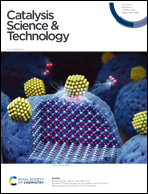Oxidative depolymerization of Kraft lignin to high-value aromatics using a homogeneous vanadium–copper catalyst†
Abstract
Lignin, the world's most abundant biopolymer with high aromaticity, has huge potential as a renewable feedstock replacing petroleum for the production of chemicals, fuels and functional materials. The enhanced utilization of lignin would improve the economic viability of existing pulp and paper mills, as well as lignocellulosic biorefineries, where lignin is highly available, but mostly incinerated for energy recovery. Catalysis could be of crucial importance to improve current depolymerization strategies, and hence contribute to a more sustainable and responsible use of terrestrial resources. In the present study, the impact of different homogeneous transition-metal catalysts on the oxidative depolymerization of a technical softwood Kraft lignin was investigated. The reactions were carried out using molecular oxygen under rather mild operating conditions and the produced aromatic monomers included, among others, vanillin, vanillic acid and acetovanillone. The best performing system incorporated a VO(acac)2–Cu(OAc)2 (V–Cu) catalyst, resulting in a bio-oil yield of approximately 50% and a total increase in aromatic monomers of 27%, on a weight basis. Moreover, a favorable combined effect between VO(acac)2 and Cu(OAc)2 was suggested by NMR spectroscopy. UHPLC-HRMS and corresponding statistical analysis revealed a more than 30-fold increase in two aromatic molecules with an oxoacetic functionality and oxalic acid as well as a focusing effect on selected molecules, when employing the V–Cu catalyst. The findings of this study indicate that the V–Cu catalyst system is promising for the efficient conversion of technical lignin into value-added aromatic chemicals. However, catalyst recycling and reuse must be demonstrated, for successful implementation under industrial conditions.



 Please wait while we load your content...
Please wait while we load your content...